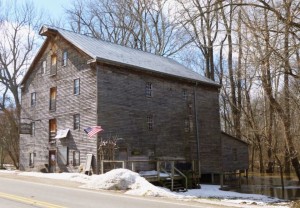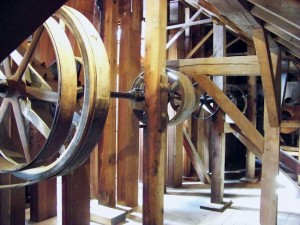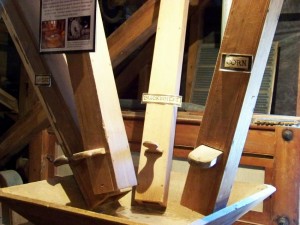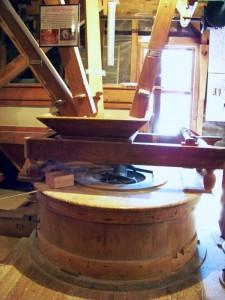No, this is not a photo of Friedrich Schinnerer’s gristmill, but I like to think his mill probably looked a lot like this one. Both mills were built in the 1840s and were located in west central Ohio.
Friedrich was my great-great-grandfather and he immigrated from Bavaria in 1849. Within two months he and his wife settled in Mercer County, Ohio, and he took over operation of John Rhodes’ water-powered grist and sawmill. The mill was located along the north bank of the St. Marys River, about two miles west of Shanesville [now Rockford], in Dublin Township. [1]
John Rhodes built the gristmill in 1840, the first flour mill in the township. Friedrich agreed to rent the mill from Rhodes for $400 per year, but in June 1850, before the contract year had even ended, Friedrich purchased the mill and 115 acres of land for $3300. He only had $1000 at the time but paid the balance from profits made from the mill. [2] [3]
Shinnerer’s Mill had one pair of stone grinding burrs [aka buhrs; mill stones], used for grinding wheat, corn, and buckwheat and Friedrich ran both the gristmill and the sawmill by himself for three years. Ten years later he built another mill, which he sold in 1873. [2] By 1876 T.J. Dull was the proprietor of Shinner’s Mill, located in Section 6 of Dublin Township. [4]
Schinnerer’s Mill is no longer standing but a few old mills have been preserved and restored and still operate the way they did nearly 175 years ago. To get an idea of the construction and operation of a mill constructed in the 1840s, we decided to visit one.
Last week Joe and I took a road trip to Bear’s Mill, located on Greenville Creek, east of Greenville, in Darke County, Ohio. Bear’s Mill is listed with the Great Lakes Chapter Society for the Preservation of Old Mills (SPOOM), under Ohio Mills by County & Mill Name. It is also on the National Register of Historic Places.
Bear’s Mill is a little larger than Schinnerer’s Mill was. Bear’s Mill is about 40 feet long and has three large sets of burrs, while Schinnerer’s Mill was 26×36 feet and had one set of burrs. [1] [2] Bear’s Mill was originally sided with black walnut and was resided with black walnut a few years ago. I imagine Schinnerer’s Mill was also a wood frame building.
Bear’s Mill was not operating the day we were there but we took the self-guided tour. We were amazed at the engineering and ingenuity that went into the construction and operation of the gristmill. I was expecting to see a building with simply a set of mill stones. I had no idea how complicated the whole milling process was. I won’t describe the whole process but I will say that a millwright and miller must have had a lot of training, skill, and experience to construct and run a gristmill.Bear’s Mill is four stories tall. Grain was hoisted up in sacks to the fourth floor by a pulley and then pulled inside. From there the grain went down and up, from floor to floor, through elevator legs, to first clean and filter the grain. Elevator legs are long, thin, square, wooden tubes that run from floor to floor, and they are all over the mill. There were also many large bins in which to store grains.
The mill works by gravity and water power. The water power comes from turbines located in the millrace below the mill. This was also a surprise to me. When I think of a water-powered gristmill I think of a water wheel. I wonder if Schinnerer’s Mill used turbines or a water wheel?
There were three large sets of granite burr stones on the second floor, probably 40-48 inches in diameter. The Bear’s Mill stones were imported from France in 1848 and cost $6000 a set. Chutes were positioned over the stones, one each for wheat, corn, and buckwheat. The grain flowed down them and went between the stones, where it was ground into flour and meal.
A skilled person, the miller, was needed to successfully grind the grain. The miller controlled the flow of the grain into the burrs. If too much grain went between the burrs the grain would not be ground completely. If too little grain flowed between the burrs it would cause the burrs to heat up. The miller also had to keep the burrs level, keep them properly surfaced, and maintain the correct grinding speed.
About 1880 roller mills became the popular method of milling, but stone-grinding is still the method preferred by many today. Stone-grinding grinds the grain in to fine pieces and does not produce much heat. retaining more nutrients and vitamins and producing a nice nutty flavor. The roller method crushes the grain and produces heat during the process, destroying nutrients. We purchased a loaf of bread baked with Bear’s Mill stone-ground flour. It was delicious with their local honey!
A gristmill provided an important service to the community and was a profitable business for the owner in several ways. The mill owner could grind his own grain and sell it. Area farmers took their grains to the mill to be ground, left some flour and meal with the miller as payment for the grinding, and took the rest for themselves.
Our visit to the old gristmill was very interesting and gave me an insight into the occupation of my great-great-grandfather, Friedrich Schinnerer.
Next: Where Friedrich Schinnerer lived and the property he owned.
[1] Mercer County, Ohio, 1853 Plat Book, Dublin Township, Section 6, p. 315 A & B, Fredrick Schinnerer; Recorder’s Office, Celina. A map of the mill’s location: https://karenmillerbennett.com/schinnerer/friedrich-schinnerer-the-flourist/
[2] Sutton, History of Van Wert and Mercer Counties, Ohio, (1882; reprint, Mt. Vernon, Indiana : Windmill Publications, Inc., 1991), 254.
[3] Mercer County Deeds Book P:25, Recorder’s Office, Courthouse, Celina, Ohio. John Rodes to Frederick Schinnerer, 25 June 1850.
[4] Mercer County Chapter, OGS, Mercer County, Ohio, Combined 1888, 1900 Atlases and 1876 Map of Mercer County, Ohio, (Mt. Vernon, Indiana : Windmill Publications, Inc., 1999); 1876 Dublin Township Directory, p. 16.


![A burr [mill stone]. (2014 photo by Karen)](https://karenmillerbennett.com/wp-content/uploads/2014/02/Bears-Mill-3-300x225.jpg)





15 comments
Skip to comment form
There is an operating (on demonstration days) gristmill near Brookville, Ind. It was built on the old canal which provided the water to turn the great water wheel. Small bags of ground flour from several types of grain are usually available for sale. The guided tours during operation by park professionals is relatively short and enlightening. Canal Days and annual flea market events present the best opportunities to catch the mill operating, though walk through visits on non-operating days are more available. During seasonal events the tiny town is overflowing with people, but otherwise it is nearly a ghost town of fake historic shops (the mill is real, but the stores in the village are mostly contrived or converted structures). The little village is call Metamora.
Author
We have been there a couple of times and enjoyed the canal boat ride. The mill there is brick.
These old grist mills are apparently pretty common. I see there are several in Ohio (Google) and I have visited at least 2 in Indiana. Could not recall the name of the one in the Great Smoky Mountain National Park, so looked it up and found that there are 4 there.
Funny how these old, old families from the area are intertwined. The “T.J. Dull” who was the proprietor Schinnerer’s Mill in 1876 was Thomas Jefferson Dull (born 4/7/1848), my great, great grandfather’s (James Monroe Dull [1/23/1846-12/25/1923]) younger brother.
Author
How interesting! Do you know anything about the gristmill TJ Dull later built about 1880? Do you know where it was located? Was it in Rockford?
AS one can still see Amish buggies carrying several large bags of livestock feed ground at local feed mills, the picture of our ancestors hauling bags of grain to the gristmill to be ground into flour seems very plausible. Even when I was a child our family hauled sugar cane to Berne Indiana to be crushed and pressed to extract the sap which was then cooked down to molasses. Such annual trips with the fruits of the summer labor to become the source of actual sustaining dietary staples were such a magical and meaningful experience, an experience almost completely absent today in our modern lives. Our connection with the source of our food is nearly lost in the vast, plastic wrapped selection of goodies from the supermarket of today.
Any idea how many gristmills were in the area? Would this one have been used by our family members in the Chatt area? Seems like a pretty good trip for most in that area, but then the Amish appear to travel that far for feed in their buggies (those that use their buggies for that job).
Author
No, but it would be interesting to know. I think Willshire had a mill at about that time period so the Chatt folks may have gone there. I imagine most gristmills were built on a river, to provide the power, unless they used horses or oxen.
Have I not seen mills operated by human power? For lack of a better description, there was a huge “hamster” wheel in which a person simply walked to turn the stones. Or am I simply creating the idea from the recent art display of the two guys living on a huge hamster wheel? While the picture seems real in my mind, I can not recall where I have seen it. Seems like it was in Metamora, but that does not make sense because they use a water wheel. Maybe the hamster wheel was a manual way to adjust the equipment without using the water powered wheel.
The use of horses or oxen brings to mind the Amish “horsepower” devices common in the Berne area. To my great surprise they are constructed from the rear axle of an old tractor. That certainly seems like a contradiction in philosophy and practice! I suspect that construction of such a gear assembly is expensive, while the rear axle of an old tractor is practically free. But is this still not ‘using’ a tractor?
I love to read your blogs! This one was especially interesting to me because I live on Rhodes Mill Road and have often wondered about the name of my road and the mill that might have been there. The location matches your description above. Rhodes Mill Rd intersects with SR 81 about 6 miles East of Willshire. If the road continued, it would hit the St Marys river just outside of Rockford. I believe you may know where this road is and might have done a Tombstone Tuesday blog about it as there is a cemetary on the corner of Rhodes Mill and 81. It is the Ridge Slater Cemetary.
I also enjoy your Tombstone Tuesdays as we have many common ancestors. My father, Roland Roehm, is your 3rd cousin. Your grandmothers, Hilda and Elsie were sisters. I have been a member of Zion Schumm my entire life and recognize the names and tombstones in many of your posts. I love learning more about the history of the area and family connections from your writings.
Author
Yes, we definately have common ancestors. I know the Roehm family and went to school with Joyce. I am sure you know her. And you live on Rhodes Mill Road! I hope to some day learn the exact location of that mill. The history of that area is certainly interesting. Thanks for writing!
I guess I wasn’t caught up with your blogs and just read the one where you have the RHODES MILL road sign where it ends and T’s into VW/MERCER CO LINE. I questioned my dad a few months ago about a possible mill that would have been on my road and he said he knew there used to be one along the St Marys near where my road would hit the river. He wasnt quite sure. I had actually tried to find more information on it. I will have to tell him about the Shinnerer connection! That makes it even more exciting!! The picture you had of where you think the mill would have been, was that on River Trail Rd or
Township Line(Alspaugh) rd?
Author
I also think it is very exciting that we had a “miller” and/or millwright in the family. And that he owned such a prosperous mill in the area. I wonder if there is any foundation or if there are any signs of the mill today. I took the photo on River Trail Road. We were heading south and started to make the turn east. We stopped right in the curve and I was took the photo a little to the southwest. Do you plan to attend the Schumm reunion this summer? If so, be sure to introduce yourself. I would love to meet you.
I would like that and will try to attend! I too have wondered if that is where it may have been located. I was interested in the mill just because of where I live, but am even more anxious to learn about it with the family connection.
Author
Ahhh! You are getting hooked! It will be nice to have another detective on the case!